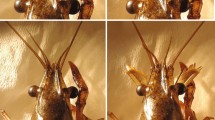Summary
1.The marine mollusc Clione limacina swims by making rhythmic movements (with a frequency of 1–5 Hz) of its two wings. Filming demonstrated that the wings perform oscillatory movements in the frontal plane of the animal. During both the upward and downward movements of the wing, its posterior edge lagged behind the anterior one, i.e. the wing plane was inclined in relation to the longitudinal axis of an animal. As a result of this inclination, the wing oscillations in the frontal plane produce a force directed forwards. 2.In restrained animals with the body cavity opened (a whole-animal preparation), the wing position, electrical activity in the wing nerve and activity of two identified efferent neurons (1A and 2A) were recorded during locomotory wing movements. There were two bursts of activity in the wing nerve during the locomotory cycle, the first one corresponding to the excitation of efferent neurons controlling the wing elevation, and the second one, to the excitation of efferent neurons controlling the lowering of the wing. Neurons 1A and 2A fired reciprocally at the beginning of the phase of elevating and lowering the wing, respectively. During excitation of one of the neurons, an IPSP appeared in its antagonist. 3. A pair of isolated pedal ganglia of Clione was capable of generating the locomotory rhythm (“fictitious swimming”). In fictitious swimming, as in actual swimming, there were two bursts of activity in the wing nerve per locomotory cycle, and the 1A and 2A neurons fired reciprocally. Homologous neurons from the left and right ganglia fired inphase. A single pedal ganglion was also capable of generating the locomotory rhythm. 4.Serotonin (10-5–10-6 M) increased the locomotor activity both in the whole-animal preparation and in the isolated pedal ganglia.
Similar content being viewed by others
References
Arshavsky Yul, Beloozerova IN, Orlovsky GN, Panchin YuV (1983) Serotonin and theophylline effects on rhythmic activity generation in buccal ganglia of gastropodial molluscs. Nejrofiziologia 15: 321–323 (in Russian).
Arshavsky YuI, Beloozerova IN, Orlovsky GN, Pavlova GA, Panchin YuV (1984) Neurons of pedal ganglia of pteropodial mollusc controlling activity of the locomotor generator. Nejrofiziologia 16: 543–546 (in Russian).
Arshavsky YuI, Beloozerova IN, Orlovsky GN, Panchin YuV, Pavlova GA (1985) Control of locomotion in marine mollusc Clione limacina. II. Rhythmic neurons of pedal ganglia. Exp Brain Res 58: 263–272.
Arshavsky YuI, Orlovsky GN, Pavlova GA, Panchin YuV (1982) Generation of the locomotory rhythm in pedal ganglia of Clione limacina. Nejrofiziologia 14: 102–104 (in Russian).
Fredman SM, Jahan-Parwar S (1980) Role of pedal ganglia motor neurons in pedal wave generation in Aplysia. Brain Res Bull 5: 179–193.
Getting PA (1981) Mechanism of pattern generation underlying swimming in Tritonia. I. Neuronal network formed by monosynaptic connections. I Neurophysiol 46: 65–79.
Getting PA, Lennard PR, Hume RI (1980) Central pattern generator mediating swimming in Tritonia. I. Identification and synaptic interactions. J Neurophysiol 44: 151–164.
Grillner S (1981) Control of locomotion in bipeds, tetrapods, and fish. In: Brooks V (ed) Handbook of physiology: the nervous system, Vol II, Motor control. Waverly Press, Baltimore/ Maryland, pp 1179–1236.
Hening WA, Walters ET, Carew TJ, Kandel ER (1979) Motoneuronal control of locomotion in Aplysia. Brain Res 179: 231–253.
Hume RI, Getting PA, Del Beccaro MA (1982) Motor organization of Tritonia swimming. I. Quantitative analyses of swim behaviour and flexion neuron firing patterns. J Neurophysiol 47: 60–74.
Hume RI, Getting PA (1982) Motor organization of Tritonia swimming. II. Synaptic drive to flexion neurons from premotor interneurons. J Neurophysiol 47: 75–90.
Jahan-Parwar B, Fredman SM (1980) Motor program for pedal waves during Aplysia locomotion is generated in the pedal ganglia. Brain Res Bull 5: 169–177.
Lalli CM (1970) Structure and function of the buccal apparatus of Clione limacina (Phipps) with a review of feeding in gymnosomatous pteropods. J Exp Mar Biol Ecol 4: 101–118.
Lebour MV (1931) Clione limacina in Plymouth waters. J Mar Biol Ass UK 17: 785–795.
Lennard PR, Getting PA, Hume RI (1980) Central pattern generator mediating swimming in Tritonia, II. Initiation, maintenance, and termination. J. Neurophysiol 44: 165–173.
Mackey S, Carew TJ (1983) Locomotion in Aplysia: Triggering by serotonin and modulation by bag cell extract. J Neurosci 3: 1469–1477.
Manteifel BP (1937) On the biology of the pteropodial mollusc Clione limacina Phipps. Bull Moscow Naturalist Soc, Biol Sect 46: 25–35 (in Russian).
Morton JE (1958) Observations on the Gymnosomatous pteropod Clione limacina (Phipps). J Mar Biol Ass UK 37: 287–297.
Porten von der K, Parsons DW, Pothman BS, Pinsker H (1982) Swimming in Aplysia brasiliana: analysis of behaviour and neuronal pathways. Behav Neural Biol 36: 1–23.
Sakharov DA (1960) On rhythmic activity of pedal ganglia in the pteropodial mollusc Clione limacina. Biol Sci 3: 60–62 (in Russian).
Shik ML, Orlovsky GN (1976) Neurophysiology of locomotor automatism. Physiol Rev 56: 465–501.
Stewart WW (1978) Functional connections between cells as revealed by dye-coupling with a highly fluorescent naphthalmide tracer. Cell 14: 741–759.
Vagner NP (1885) Invertebrates in the White Sea (in Russian).
Author information
Authors and Affiliations
Rights and permissions
About this article
Cite this article
Arshavsky, Y.I., Beloozerova, I.N., Orlovsky, G.N. et al. Control of locomotion in marine mollusc Clione limacina I. Efferent activity during actual and fictitious swimming. Exp Brain Res 58, 255–262 (1985). https://doi.org/10.1007/BF00235307
Received:
Accepted:
Issue Date:
DOI: https://doi.org/10.1007/BF00235307




